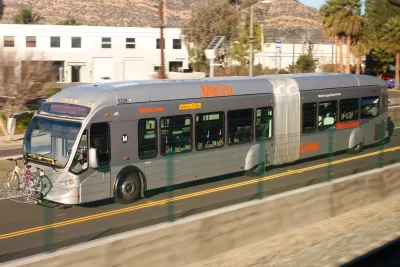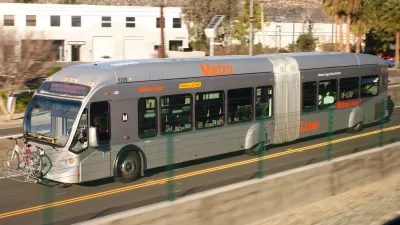The Orange Line, a bus rapid transit line running through Los Angeles' San Fernando Valley, has been a success. To those calling for an expensive conversion to rail, several experts say, why bother?

Dating from 2005, L.A.'s Orange Line now serves more than 25,000 riders a day. Patrick Sisson writes, "In its 12 years of service, the Orange Line has carried more than 74 million passengers and proven there's an audience and ridership in the region. It's so successful that it's often crowded at rush hour, leading Metro to explore an upgrade."
Calls for a light rail replacement have encountered pushback from many experts. "The push to lay down track and replace a successful bus line begs another question: Can a bus line, even with all the right support, ever be enough?"
Juan Matute, associate director of UCLA's Lewis Center and the Institute of Transportation Studies, says the Orange Line has succeeded on many levels. "'The Orange Line has been an extremely cost effective transportation amenity,' [Matute] says. 'You could build five Orange Lines for the cost of a light rail corridor.'"
Rail advocates argue that the conversion will spur efficiency gains. It'll also cost an estimated $1.4 billion. Sisson writes, "If the bus line were treated like rail, instead of being replaced by rail, the transit authority could accomplish many of the same efficiency gains at a much lower cost."
FULL STORY: Can the Valley’s Orange Line—the nation’s most successful BRT—get any respect?

Maui's Vacation Rental Debate Turns Ugly
Verbal attacks, misinformation campaigns and fistfights plague a high-stakes debate to convert thousands of vacation rentals into long-term housing.

Planetizen Federal Action Tracker
A weekly monitor of how Trump’s orders and actions are impacting planners and planning in America.

In Urban Planning, AI Prompting Could be the New Design Thinking
Creativity has long been key to great urban design. What if we see AI as our new creative partner?

King County Supportive Housing Program Offers Hope for Unhoused Residents
The county is taking a ‘Housing First’ approach that prioritizes getting people into housing, then offering wraparound supportive services.

Researchers Use AI to Get Clearer Picture of US Housing
Analysts are using artificial intelligence to supercharge their research by allowing them to comb through data faster. Though these AI tools can be error prone, they save time and housing researchers are optimistic about the future.

Making Shared Micromobility More Inclusive
Cities and shared mobility system operators can do more to include people with disabilities in planning and operations, per a new report.
Urban Design for Planners 1: Software Tools
This six-course series explores essential urban design concepts using open source software and equips planners with the tools they need to participate fully in the urban design process.
Planning for Universal Design
Learn the tools for implementing Universal Design in planning regulations.
planning NEXT
Appalachian Highlands Housing Partners
Gallatin County Department of Planning & Community Development
Mpact (founded as Rail~Volution)
City of Camden Redevelopment Agency
City of Astoria
City of Portland
City of Laramie




























